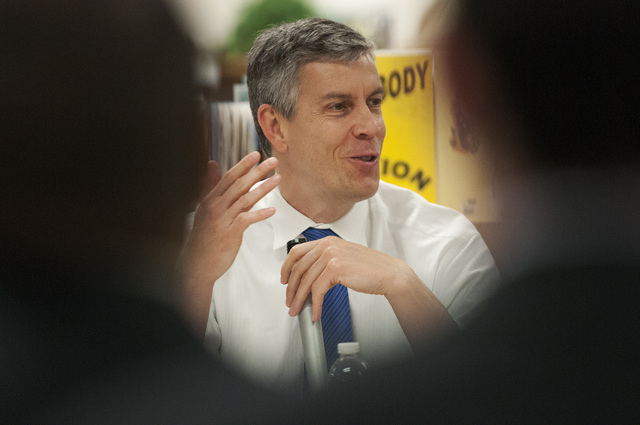U.S. secretary of education shown Clark County School District successes


Clark County public schools may be struggling according to almost every assessment, but they have a “chance to break through,” according to U.S. Secretary of Education Arne Duncan, who visited the nation’s fifth-largest school district for the first time in more than two years on Wednesday.
“This is a district that has the opportunity to make incredible progress,” Duncan said after meeting with 11 principals from Clark County’s highest-performing or fastest-improving schools.
Largely because of Clark County, Nevada’s public school system ranked dead last in the nation for a second year running, according to a 2013 analysis from the Annie E. Casey Foundation on the rate of fourth-graders reading at grade level, eighth-graders with grade-level math skills, graduation rates, and the number of children attending preschool.
Less than two-thirds of Clark County students graduate on time, according to the Nevada Department of Education’s most recent data for the 2011-12 school year. But Duncan said that’s the past — he’s focused on the future and has high hopes for the Clark County School District.
He pointed to Bracken Elementary School, near Eastern and Washington avenues, where he met with principals and Clark County Superintendent Pat Skorkwosky, as a reason to be optimistic.
The U.S. Department of Education, headed by Duncan, awarded Bracken a National Blue Ribbon Award this year for its progress, one of only three earned by Nevada schools.
“It was our low expectations keeping students exactly where they were,” said Bracken Principal Katie Decker. The school demands much of its students and religiously tracks student progress while involving parents in education.
Duncan agreed that more needs to be asked of American students, recalling a meeting he had with exchange students who said expectations were higher in their home countries.
“We’re asking less of our students, setting them up for failure,” said Duncan, pointing to the schools represented in the room as models that need to be duplicated across the 357-school district.
“Our school would not function without community support,” Decker said. She offered just two words when Duncan asked what these top principals need to sustain their success. “More funding.”
The principals spoke of teachers’ and principals’ frustration over the monumental challenge of switching to Common Core standards without enough training. They said not offering enough training is provided for new principals who are often promoted without much preparation for being a school leader.
Clark County schools don’t have up-to-date textbooks. Duncan asked if the district is instead giving each student an iPad and using digital books.
Nope, answered Skorkowsky. Just nine of 59 middle schools offer iPads. Clark County schools have been relying on aging textbooks for years, which is what President Barack Obama discovered in 2012 when he talked to a Canyon Springs High School teacher using 10-year-old history and government textbooks.
“We had to balance the budget,” so no new textbooks, said Skorkowsky.
Duncan acknowledged Nevada’s “low funding” for education. The state spent about $8,527 per student in 2011 compared to a national average of $10,560 per student, according to a 2013 report by the U.S. Census Bureau.
Only North Carolina, Tennessee, Mississippi, Arizona, Oklahoma, Idaho and Utah spent less on education.
Unfortunately, Congress sees education as an “expense” while others see it as an “investment,” Duncan told the school leaders.
But it’s also a local decision.
“The simple fact is, on a relative basis, Nevada invests less (in education),” said Duncan, noting that “without community support, we in education are not going to win in this battle.”
However, he said, “money alone is never the answer.”
He pointed to Tennessee, which spends $285 less per student than Nevada, but was the state to make tremendous gains this school year, according to the U.S. Department of Education’s National Assessment of Educational Progress — also called the Nation’s Report Card – given this year to 719,000 students nationwide in fourth and eighth grades, which are seen as educational milestone years.
Average scores of Nevada’s students, on the other hand, fell short of the national average in math and reading for both grades, a dubious showing made only by the Silver State, California, New Mexico, Oklahoma, Louisiana, Mississippi, Alabama, South Carolina, West Virginia, and the District of Columbia.
Contact reporter Trevon Milliard at tmilliard @reviewjournal.com or 702-383-0279.


















